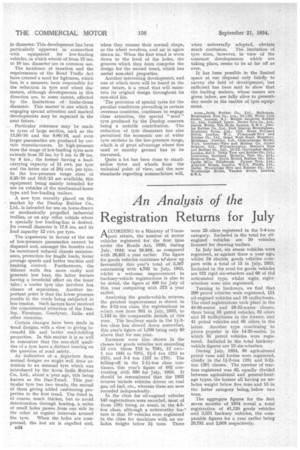An Analysis of the
Page 82

If you've noticed an error in this article please click here to report it so we can fix it.
Registration Returns for July ACCORDING to a Ministry of Transport return, the number ól motor vehicles registered for the first time under the Roads Act, 1920, during . July, 1934, was 29,895, as compared with 26,431 a year earlier. The figure for goods vehicles continues to! show' up favourably this year's total of 5,367 contrasting with 4,762 in July., 1933, talnilst a welcome improvement in hackney-vehicle registrations is also to be nbted, the figure of 469 for July of this year comparing with 375 a year earlier.
Analysing the goods-vehicle returns, the greatest improvement is shown in the 2-2i-ton class, the registrations in which rose from 903 in July, 1933, to 1,142 in the comparable mbuth of this year The headway made in the l-2ton class has slowed down somewhat, this year's figure of 1,390 being only 40 above that for last year.
Increases were also shown in the classes for goods vehicles not exceeding 12 cwt. (from 712 to 788), 12 cwt.1 ton (641 to 728), ton (23.1 to 315), and 3-4 ton (157 to 170). The falling-off in the 1-14-ton class continues, this year's figure of 482 contrasting With 580 for July, 1933. It should be remembered that the 1933 returns include vehicles driven on coal .gas, Oil fuel, etc., whereas these are now recorded independently.
In the class for oil-engined vehicles 143 registrations were recorded, naost of them (38) being, as usual, in the 4-5ton class, although a noteworthy fea-* tore is that 18 vehicles were registered in the class for machines with an unladen weight below 24 tons. There
were 25 oilers registered in the 24--ton category. Included in the total foi. oilengined vehicles are 30 vehicles licensed for drawing trailers.
In July last, six steam vehicles were registered, as against three a year ago, whilst 34 electric goods vehicles cornpare with a total of 15 in July, 1933. Included in the total for goods vehicles are 152 rigid six-wheelers and 60 of th6 articulated type, whilst eight eightwheelers were also registered.
Turning to hackneys, we find that 299 petrol vehicles were registered, 151 oil-engined vehicles and 19 trolleybuses. The chief registrations took place in the 48-56-seater and 26-32-seater classes, there being 55 petrol vehicles, 52 oilers and 15 trolleybuses in the former, and 41 petrol vehicles and 65 oilers in the latter, Another type continuing to prove popular is the 14-20-seater, in which 61 petrol vehicles were registered. Included in the total hackneyvehicle figures are 13 six-wheelers, During July, 1934, 80 agricultural petrol vans and lorries were registered, chiefly in the 14-2-ton (28) and 2-21ton (20) classes. The number of tractors registered was 42, equally divided between agricultural and general-haulage types, the former all having an unladen weight below five tons and 15 in the latter category being, below two tons.
The aggregate figures for the first seven months of 1934 reveal a total registration of 41,120 goods vehicles and 3,331 hackney vehicles, the comparable figures for a year earlier being 29,781 and 2,608 respectively.








































































































































































